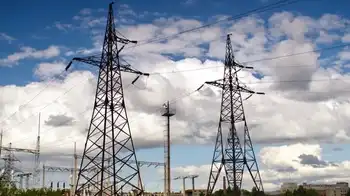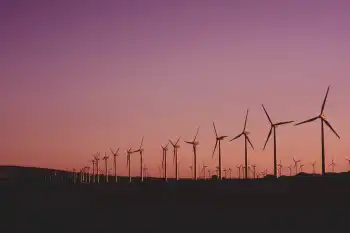Race to build deep-water wind farms is a long one
By Associated Press
Arc Flash Training CSA Z462 - Electrical Safety Essentials
Our customized live online or in‑person group training can be delivered to your staff at your location.

- Live Online
- 6 hours Instructor-led
- Group Training Available
Yet even talk of placing huge turbines in shallow waters off scenic shores can raise an enormous public outcry.
Behind the scenes in the U.S. and in Europe, the race is on to build the world's first deep-water wind farms, ones that would operate on floating platforms in waters hundreds of feet deep, like oil rigs found in the North Sea and the Gulf of Mexico.
There are gargantuan technical hurdles, but there is also the potential for a huge payoff, said Habib Dagher, who is working on a deep-water wind turbine at the University of Maine.
"We can open up the largest renewable resource that the U.S. has," he said.
About 78 percent of the nation's electricity is consumed by people on the East and West coasts and along the Great Lakes, all places with enormous wind potential.
The potential in the U.S. and elsewhere has drawn a number of players into the race.
Boston-based Blue H USA is seeking permission to put a demonstration floating turbine in federal waters 23 miles off the coast of Massachusetts' Martha Vineyard.
Blue H's affiliate, Blue H Technologies BV in Denmark, has a 2/3-scale demonstration turbine operating off southern Italy and has proposed a full-scale prototype off France. It is also part of a consortium of companies that has proposed building a wind farm on floating platforms in the North Sea, with the first turbines being constructed as soon as 2013.
Elsewhere, the Norwegian company StatoilHydro is building a pilot wind turbine to be installed off Norway next year and tested over a two-year period. StatoilHydro says the windmill will be able to be placed in depths from 350 feet to more than 2,000 feet.
Another Norwegian company, Sway, has designed a turbine for offshore use that has no platform and would be tethered to the ocean floor.
Texas oil tycoon T. Boone Pickens has brought a lot of attention to wind power with a plan for large-scale projects in the Midwest. Land-based wind turbines this year will supply 48 billion kilowatt hours of power in the U.S., enough to meet the electricity needs of 4.5 million homes, according to the American Wind Energy Association.
But it makes more sense to look out to sea, where the nation's best winds and greatest population densities are found, said Raymond Dackerman, general manager of Blue H USA.
"With all due respect to North Dakota and South Dakota, which have also been labeled the Saudi Arabia of wind, people live along our coastlines," Dackerman said. "It's relatively easier to cable back in from offshore locations into demand centers as opposed to creating projects in locations that are far from population centers."
Europe already has shallow-water wind farms, mostly off Denmark and the United Kingdom. And the United States' first ocean-based wind farms are expected to begin operating in shallow waters off Atlantic Coast states in the coming years.
Erecting wind turbines in shallow-water sites is relatively simple. Huge steel stakes are driven into the ocean bottom to ground turbines.
But that's not feasible farther offshore, where winds are stronger.
Putting turbines far out to sea is a long-range goal, but the most recent energy shock has sparked more interest, said Walt Musial, one of the nation's top wind power experts.
"All we have now are computer models, so we need more testing in the ocean," said Musial, an engineer with the Department of Energy's National Renewable Energy Laboratory in Golden, Colo. "We don't know yet what the detailed requirements are for a deep-water offshore site."
Dagher testified with Pickens about wind power before the Senate Homeland Security Committee in July.
Winds in the Gulf of Maine blow at 20 to 22 mph on average, compared to wind speeds of 15 1/2 to 18 1/2 mph in the Midwest, Dagher said. While the difference may not seem great, those offshore winds can produce 2 1/2 times the electricity of land-based turbines.
Placing turbines far offshore also eliminates the eyesore factor for people who might object to large towers in their view, he said.
In addition to the technical challenge of building 300-foot towers 10 to 20 miles offshore, developers must find out how best to route power back to land through cables buried under the ocean floor.
Shipping lanes, marine mammals, fishing boats, sea birds and even airplanes, and how their radar would be affected by ocean towers, have to be considered.
There are also the financial costs, regulatory obstacles, not to mention hurricanes.
Dagher, who has been working with several companies on his prototype turbine, envisions wind farms 20 to 30 miles out in the Gulf of Maine — but not for at least 10 years.
StatoilHydro spokesman Oistein Johannessen said offshore wind power is evolving the same way offshore oil drilling did. The early oil rigs were in shallow waters on concrete platforms, and eventually went deeper and deeper until they became floating platforms far at sea.
"I think it's important when we think about this that we keep in mind this is a long-term perspective," Johannessen said. "We're talking about 10 years-plus, or 20 years maybe, before the technology is available on commercial terms."
While the technology isn't perfected yet, Musial said the interest is there. And, he added, one thing is for sure: "The wind is there."











